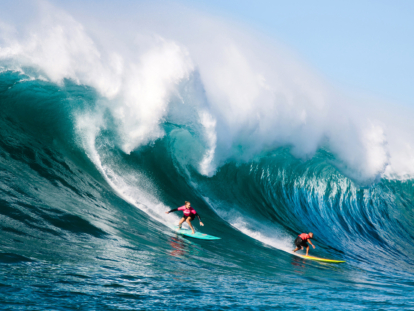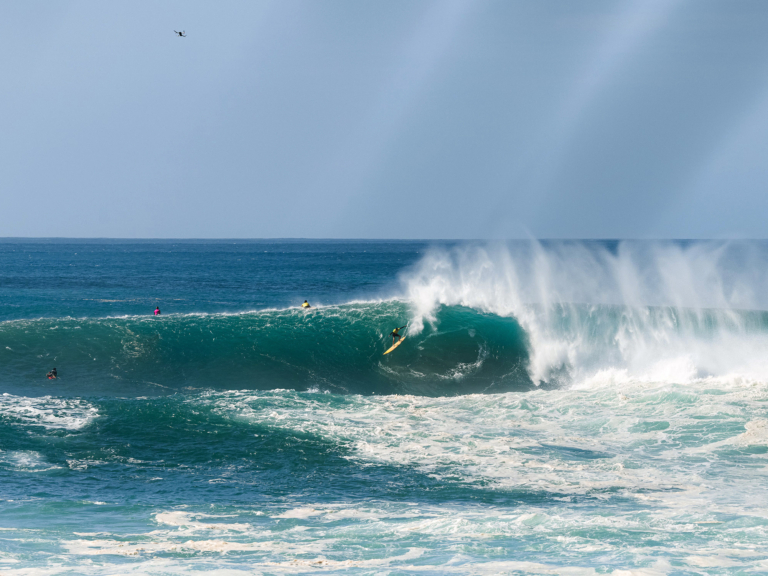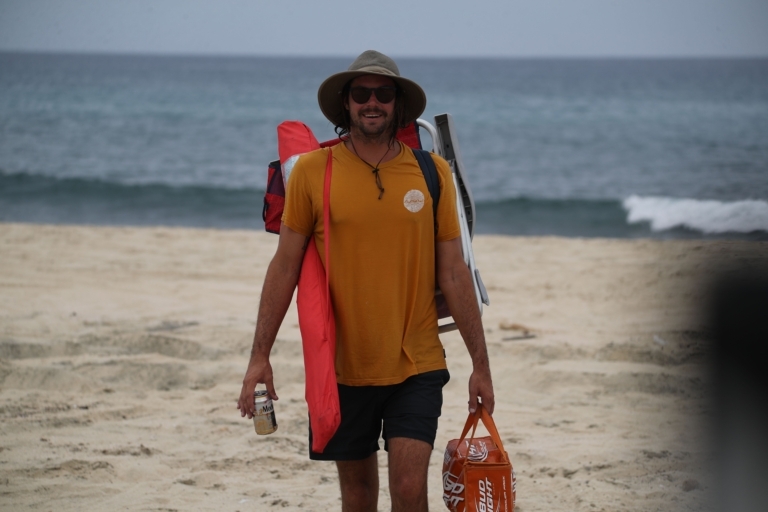A Hog of a Swell Greets the Eddie
Scenes from ground zero of the greatest surf event in seven years.
On January 10th, the greatest show in surf, the Eddie Aikau Big Wave Invitational’s light switched from yellow to green. A swell significant enough to honor the North Shore’s first lifeguard and big-wave surfing pioneer, the late Eddie Aikau, was forecasted to fill into Waimea Bay two days later. Big-wave surfers from around the world scrambled to get to Honolulu International Airport. When Ramón Navarro’s flight was canceled, he was halfway to O‘ahu from Chile. He wouldn’t make it in time. “I was crying, man,” he says. “Like, ‘I can’t believe I’m going to miss the Eddie!’”
Lucky for Ramón, the Bay calls the day. The aptly named “almost-Eddie” swell did not prove to be of caliber; however, it did send XL waves to Maui and California. For the Eddie to run, Waimea Bay must guarantee 20-foot-plus Hawaiian, or 40-foot-plus, waves. At the last minute, Eddie’s brother, Uncle Clyde Aikau, called it off.
One does not argue with the Bay.
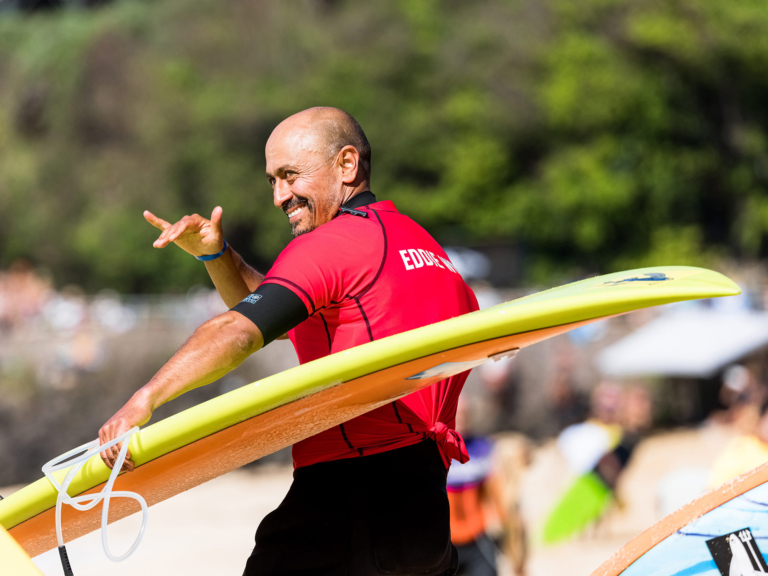
Travel snafus be damned—Ramón made it to the Bay when it mattered. Photo: Ryan “Chachi” Craig
False starts like these happen almost every year. Each winter, the 40 invitees and 18 alternates stay on-call from mid-December to mid-March, and those who live more than 48 hours of travel away often set up camp on O‘ahu or Maui, waiting for the green light. Throughout the Eddie’s 38-year history, the event has run just nine times—the last was in 2016.
“Everyone that surfs big waves knows it’s the biggest show in town and the most respected event in big-wave surfing,” says Kohl Christensen. “To be a part of it is a crazy dream for all of us.”
Nine days later, though, the Eddie is back on, and Ramón—no cancelled flights this time—is talking to Greg Long at Kohl’s house in Waialua, O‘ahu, on the eve of the event. Greg spent the past few days caring for his friend Coco Nagoles, who’d broken his pelvis while surfing Todos Santos off the coast of Baja California. After a nightmare experience with the local hospital, he rushed Coco back to California for surgery, rounded up his things and hopped on a flight to Honolulu. Fellow Patagonia Surf ambassadors Paige Alms and Ian Walsh will join them tomorrow, both coming from nearby Maui.
Outside in the yard, Kohl’s daughters, Hakea and Mehana, are strumming their ukuleles, singing and dancing on a storage container. They’re 3 and 5 years old and are the night’s entertainment. Each song ends to hoots and enthusiastic applause, and from the beachfront property, the crescendo of a building swell accompanies their performance. When the show ends, Kohl, Ramón and Greg philosophize on what tomorrow will bring. The swell charts look wild. The buoys are reading 27 feet at 19 seconds. BIG. Or as Ian Walsh would later put it, “this is a hog of a swell.”
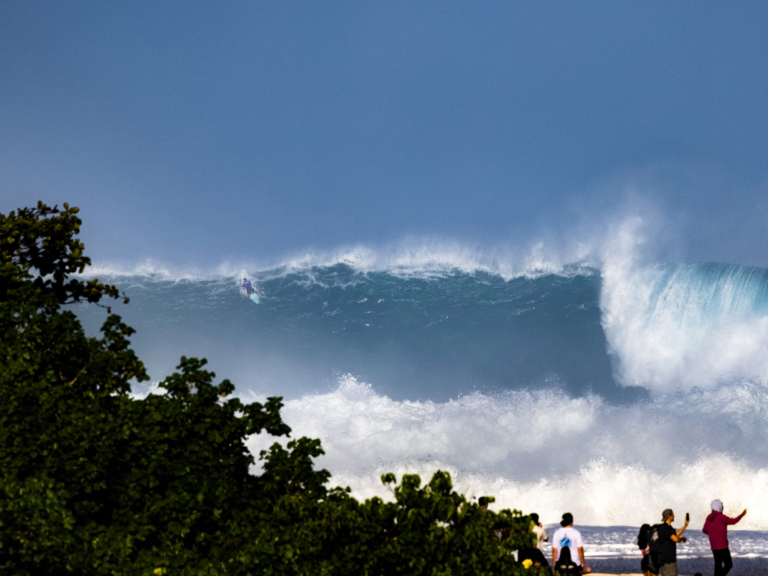
Ian Walsh scrapes over a hog of a wave. Photo: Ryan “Chachi” Craig
By 8 p.m., it’s time for bed. Greg, who won the Eddie in 2009, is in the first heat, and he plans to paddle out at dawn to get a few before the official start.
Meanwhile, getting there is on everyone else’s mind. The general sentiment for those who’ve attended an Eddie is, if you want a good spot, get there at 4 a.m. Earlier today, cars started lining up and camping on Kam Highway, miles and miles back in every direction. Tomorrow, the two-lane road that wraps around Waimea Bay and into the Seven-Mile Miracle is sure to be slow going. Much slower than most Sundays when tourists are rubbernecking to watch the sea turtles up the road at Lanikai Beach.
At 6 a.m. the next day, I’m headed down. Remnants of last night’s car-camp parties and bonfires line the roads, and a steady stream of contest-goers marches on.
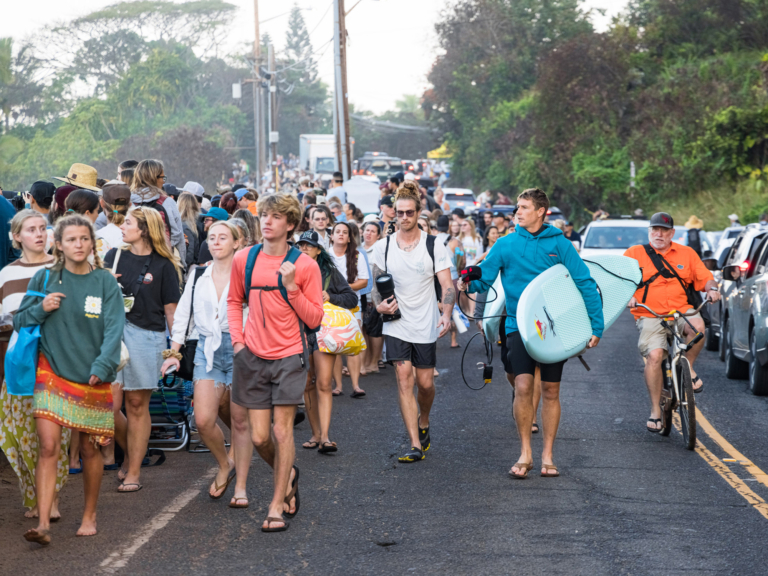
It’s the same road for all. Ian Walsh makes his way down Kam Highway on the morning of the Eddie. Photo: Ryan “Chachi” Craig
The Bay reveals itself at the western ridge. People are packed in. Canopies line the cliff and someone with turntables is spinning house music over the rumble of the ocean below. It’s big. Real big. Getting bigger. The beach and the ridge are shoulder to shoulder. Searching for space, people funnel up the hill across the road and down through the bushes onto the cliff by the coast. It’s barely light out and it looks like the entire population of O‘ahu—and then some—is here.
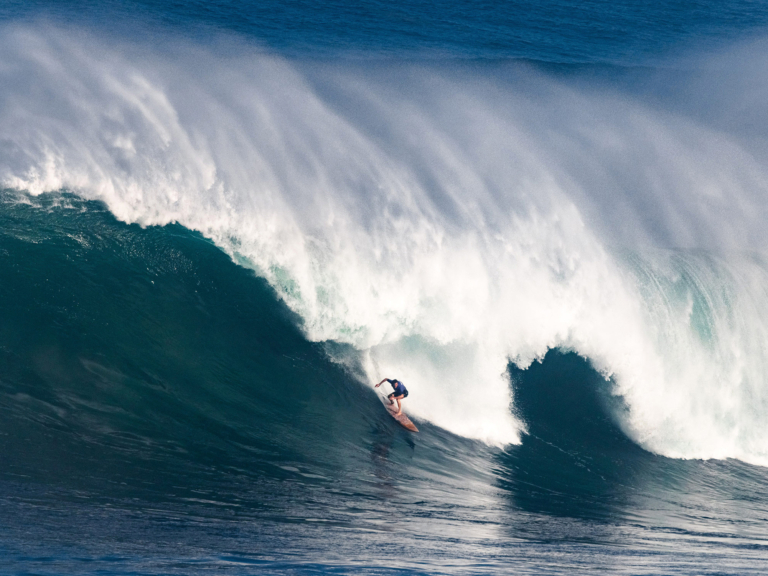
2009 Eddie Champ, Greg Long on a Waimea bomb. Photo: Ryan “Chachi” Craig
It’s minutes before the event. Each crashing wave exhales its unwanted water particles out of the Bay, cloaking the contest zone in salt and mist. Ten competitors bob in the lineup. The crowd goes berserk as someone paddles over the ledge and down a 40-foot face before the heat starts. Everyone’s asking, “Who was that?” Nobody knows.
At 8 a.m., the horn blows; the Eddie is on.
“When I showed up this morning in the dark, I was a little bit nervous, to be honest,” Greg said after his heat. “The buoy readings were way bigger than anyone could have imagined. But then the sun came out and those nerves turned to excitement. I just wish I had another couple hours to sit out there and get a good one.”
This year, the event is a little different. In 2017, the Aikau family severed ties with the Eddie’s long-term title sponsor, Quiksilver. For a moment, the Eddie was thought to be dead. The following year went by without the annual opening ceremony. But for the 2019–2020 winter, the Eddie Aikau Foundation piecemealed the funding together through nearly 20 sponsors committed to keeping it alive.
“We brought the Eddie back to its Hawaiian roots,” the 1987 event winner, Clyde Aikau, told me on the future of the event in 2020.
Today, the atmosphere and security are lax, more so than when Quik footed the bill. The prize purse is also smaller, but the competitors don’t care. That’s not what this event is about. The Eddie still features the best big-wave surfers in the world: guys like Michael and Mason Ho, John John and Nathan Florence, Shane Dorian, Nathan Fletcher, Makuakai and Koa Rothman, Ross Clarke-Jones, Grant Baker, Billy Kemper, and plenty more. But most notably, for the first time ever, six women invitees—Paige Alms, Keala Kennelly, Emily Erickson, Makani Adric, Andrea Moller and Justine Dupont—are part of the chaos rumbling through Waimea Bay’s natural amphitheater. They’re in the same 10-person heat draws as the men.
At 11 a.m., Paige Alms makes her way down the beach. Hordes of surf fans shout her name and wish her luck. As she walks to the water line, the crowd’s volume rises and Paige runs into the water, jumps on her board and turns turtle through the thumping shore-pound. Hawaiian Water Patrol pulls a ski in front her; she grabs the sled on the back, pulls her board out of the water and zips into the lineup.
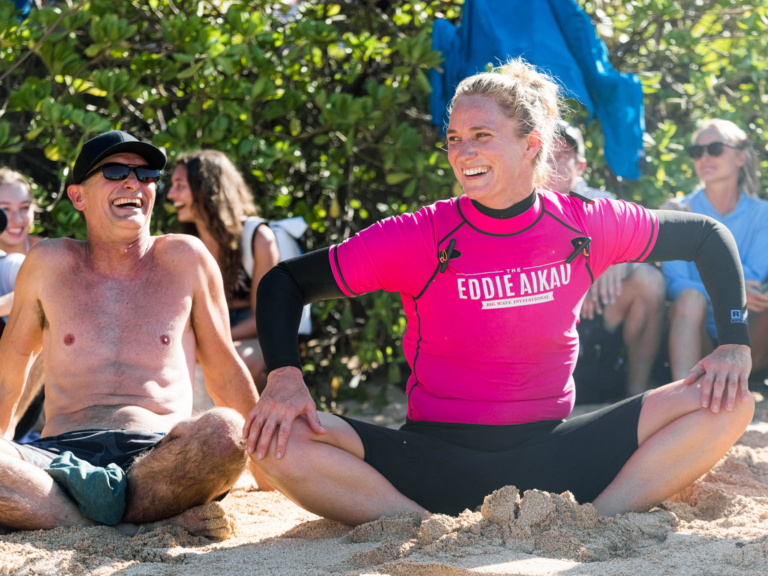
Paige, pre-heat with her partner and surfboard shaper, Sean Ordonez of SOS Shapes. Photo: Ryan “Chachi” Craig
“To get an invite to the Eddie is something I never in my wildest dreams would have thought about as a kid,” Paige said after her heat. “And I get to share this experience with a lot of my heroes, peers and friends that I’ve grown up with. It’s a magical day. That’s what this event is all about, sharing that camaraderie in the ocean.”
In the competitors’ and family area, cars fit in where they can on the lawn above the sand. Sunshades are raised, coolers filled; it’s a bluebird day and the sun’s belting. Some actively watch the event. Others chill out on the grass, occasionally running to see the action when prompted by the excitement of the crowd. Over the loudspeaker, the North Shore Lifeguards make safety PAs to those on the sand, at the river mouth, on the cliffs and rocks.
“Attention near the river mouth, this one’s going to come up again. Get high and dry!”
“Whoever’s kid that is, get him off the rocks … even if it’s not your kid, get him off the rocks!”
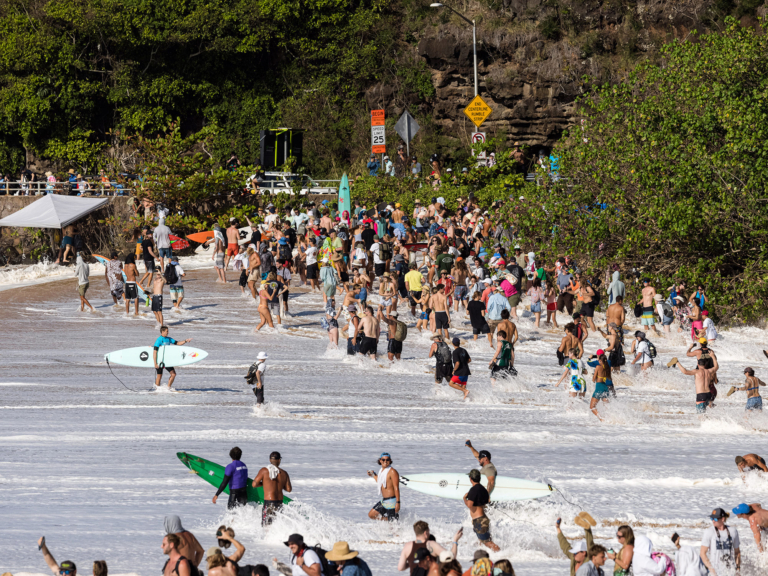
Hold onto to your personal items and stand your ground. Photo: Ryan “Chachi” Craig
The people don’t listen, and over and over white-water rushes through the folks standing on the sand, taking out ankles, adults, children and frying expensive cameras. The unique problem the Eddie poses to the guards at Waimea is ironic. It’s the most dangerous day of the year to stand on the shores of Waimea Bay, and an estimated 50,000 people showed up.
The madness of it all makes the Eddie the most entertaining surf event there is. But the community it brings together makes it truly unique. On the sand, cliffs and lawn, it’s smiles and high-fives, hoots, hugs and cheers; the energy is electric, its significance living and breathing with the heroics of the surfers and the crowd’s bellows. The scene is incredibly cordial considering the volume of people—everyone connected through Eddie’s legacy and the power of the Bay.
“I feel like life gave us a lucky hand to be able to be part of something so special,” says Kohl. “Each heat, I took one quick moment to look back at all the people. You could hear them. You could hear the roars. There’s nothing like it.”
Kohl Christensen, from the shoreline to the lipline. Photo: Ryan “Chachi” Craig
Kohl Christensen, from the shoreline to the lipline. Photo: Ryan “Chachi” Craig
In the water, it looks less like a competition than friends sharing their love for big-wave surfing. “There were gnarly competitors in every single heat,” says Ramón. “Everyone was having good vibes, actually asking, ‘You want to go this one, or I go?’” Even so, everyone wants to be the 10th-ever Eddie winner.
At 2 p.m., the swell peaks, and a corduroy pattern stacks out to the horizon. Waves begin to roll in by the dozens, and a new sense of urgency rushes over the Hawaiian Water Patrol. It’s critical, but they’re the best in the biz. As another set closes out the Bay, the crowd erupts at a well-executed late drop, then a body free-falling 30 feet from the lip. Some skis get caught inside, and are forced to wait it out, while the others scoop fallen surfers from harm.
“The Hawaiian Water Patrol did an impeccable job. They’re some of the highest caliber watermen, nonstop all day,” said Kohl the next morning. “Navigating closeouts, all the wipeouts and managing all the surfers. I got sucked over the falls in my first heat on a closeout and got rattled a couple times. They were right on me.”
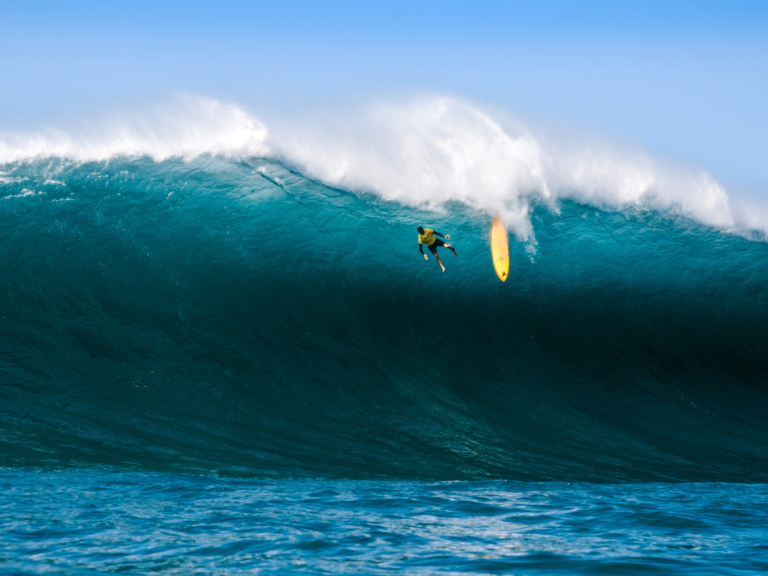
Kohl suffered a traumatic brain injury at Pipeline a few years back. He’s recovered, and this winter, he returned to surfing Pipe on the big days and also surfed in his third Eddie. He now wears head protection and is a bit more calculated in the water. But … once a sender, always a sender. Photo: Christa Funk
By 4 p.m. the last horn sounds. The Eddie is over, but no one knows who won. Beers crack and clink in the competitor’s area. We shuffle toward the stage behind the scaffolding to watch the awards. It’s shoulder to shoulder and hard to see—something we’ve become accustomed to throughout the day. A man in a yellow-and-red uniform stands with the competitors. He looks out of place. His name is Luke Shepardson, North Shore Lifeguard and underground hellhound.
“Uncle Clyde always says, ‘Eddie will pick the winner,’” says Kohl. “He picked the on-duty lifeguard. How fitting.”
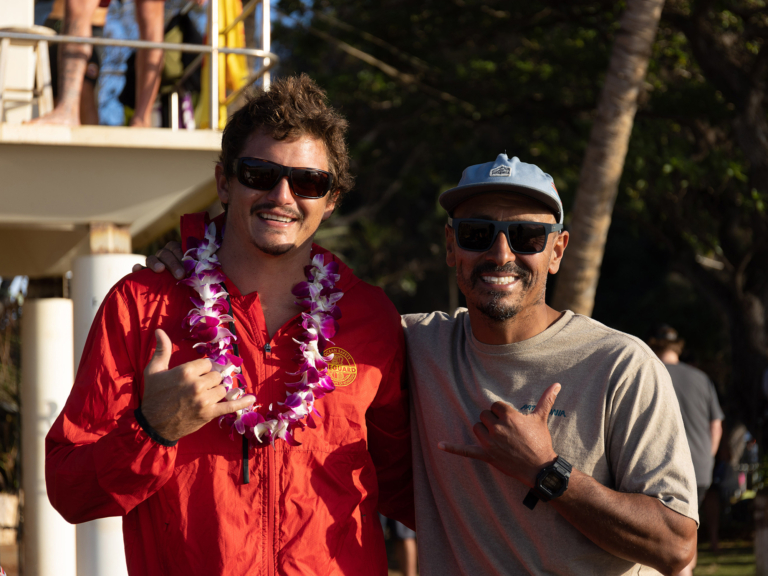
Luke Shepardson and Ramón when the event ended, and the non-competitors paddled out. Photo: Rodrigo Farias Moreno
“I saw him rescue people this morning,” chimes Ramón. “He took two two-hour breaks to surf in two heats and won the Eddie while working. It was magic to see that.”
When the contest ended, Luke handed his check to a friend, got back in his tower and finished his shift.
For a candid conversation with Paige Alms and Sean Doherty on her experience surfing the Eddie, head to Roaring Journals.
